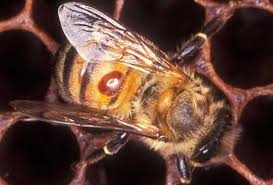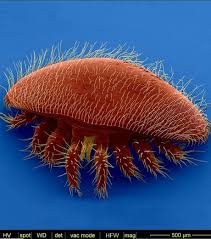Welcome to the Buzzing about bees blog! Here you will find all the information we have gathered so far about the bees and how they are progressing.
Firstly, here are some links to videos we have made so far about the bees.
John is our local beekeeping expert and he is guiding us through the process of looking after and growing the bee hive. His advice and expertise are invaluable and he is able to spot the queen among a frame of 1,000 bees!
Important events so far
- we have found the queen and she is laying eggs! (see picture below)
- the bees have filled up the first box with eggs and honey, so we have added another box called a “super” on top to give them more space.
- Some of the male bees have a disease called “deformed wing virus”! This means that their wings aren’t fully formed and the bees cannot fly. This is caused by a parasite called the varroa mite. Which exists in almost every bee hive in the world. We will monitor this and perform a treatment at some point! (see picture below)
- In September and October we will feed this bees a sugar syrup to get them strong enough to survive the winter.

the queen is on the right, she is longer and pointier than the other bees.


A male bee with Deformed wing virus.
here is a varroa mite feeding on a bee and a microscope picture of one. If a bee was the size of a human, the varroa mite would be the size of a football!
If you want to read more about them, here is a wikipedia page with lots of information


https://en.wikipedia.org/wiki/Varroa_destructor
Over the next few weeks look out for
- Children cleaning the floor of the hive and they performing a varroa mite count to see if treatment is needed.
- John is coming back to help us mark the queen with a white dot so she is easier to find.
- Children making up sugar syrup to feed the bees and cleaning the bee feeder, which is getting sticky and messy!






![IMG_0955[1]](https://glow-prod-nl.s3.eu-west-1.amazonaws.com/nl/public/buzzingaboutbees/uploads/sites/30364/2016/08/IMG_09551-e1471967852667-225x300.jpg?X-Amz-Content-Sha256=UNSIGNED-PAYLOAD&X-Amz-Security-Token=IQoJb3JpZ2luX2VjEJj%2F%2F%2F%2F%2F%2F%2F%2F%2F%2FwEaCWV1LXdlc3QtMSJIMEYCIQDr3oGi34hfVLUo2esJi4FYonjl%2FavWSoh%2FyFFbqw5KcwIhANtwbshZ9RZVfyri7XSLqPDosDrFpd%2Fgwwr5Jt8rSpYhKsEFCIH%2F%2F%2F%2F%2F%2F%2F%2F%2F%2FwEQBRoMMjczNTcwMTk1NDMzIgxQSI1r9RCJm7ssnFMqlQV4p0i%2B3yQzIh1IRyWzU9T1YgwA9Qf3At%2B%2F1pxcyaeGDqvbeFlBleCxqdZX4hBfNpEOLqwupIg%2BfoEayxGVLCbQ67WKqoFGwrCV0FlHxtVsCgXFP1PPKtUftngo8kR4mUTzLpDhvrL6FZCNhpIqPynkPuNoyyV14ht%2BH5tJIp1gG5TCEv7YESzf5SVzdDNGyoYYnJTwMfxsN4F1GZOlPZhh2QN90N%2Bg8i%2B3dvuuabnkc8ldPuBUMfxOrbCL50ljn2i%2BhiLW4Ipkb%2F6Nc%2BF5mj9zBGKrdpoYaXJt0STsuB%2FqLFX0pCgTiAr3ElloZc8rWHB3L8ywMcGiTsGsIh073EeN47n6srfMh2BnRSCCjt1%2FPx2WqwrhqBtf5TFNKtZGobPppxQgQPguzYhYgzXzxeaydXvo9yvBM8XItsKNdqCDK3Ct6gNlin3RxmylHgq9TJgwtTt62tg5zq52QLYI%2B8tsmZghIciTS7%2FpfswsqQ46EPr2Ix%2Ft6U%2F6bOh3Py2fiZaWLfrkgYSEMA6Mm5qbAVTVWbk8gsxpfEKzq4s%2FNTbVZaIIEBgEdnpbKJvJnLKPoqoeYZ2CYsG5fc2miwaCjxBaUWn0VeZI7yrMrNSBsZ2MEf%2FjmrUj86HT9HxBqvUmROR9A0vGtcNiGCV2%2FVATussNqbsa5ez3KmWEbi2rFIjGaSHrhsztah0BfgwzZg286mn0EHjmD%2FVq8bysrD2gd90LoivfArsE%2B2ZcZYjHP5yCkCam63mDfBle7O9rn%2BohKs0OWEWlyXDIDX0wfvGFaP8s9ckZLHiUYW%2FHkm9beB9yBCAuBiGpc%2FBchaLimTAW%2Bu%2FKbwvJcD92LkLVgLX1bpMXIeQqdGlmiG7Z4e5U4zNd01MDcJrUMMaY%2FLsGOrABBoUAiaNIM1TJDyEUK9APTaUHWQ%2BV0rKVeNZ6KelK7N%2F9I3II0XOc%2FP4DzmrE%2FchffsZ8uevpF8OKoOMsLszvNqCLdUcGcvhaZGqWJjm8Sa%2FFbcgJk3X%2FC6MpKzHclaBrqIjHQpCP5KlnuetIT6KKdkPHGcrYkjTpYfOtBmJrw9rvN5jxY43Q9gjRp6pPnfxhbeiUF7yUxMJTu7Y9jtY3%2BRAoaDFlG2iGTUNOOKY%2BXXM%3D&X-Amz-Algorithm=AWS4-HMAC-SHA256&X-Amz-Credential=ASIAT7MQN47UTK3HOYL7%2F20250108%2Feu-west-1%2Fs3%2Faws4_request&X-Amz-Date=20250108T235404Z&X-Amz-SignedHeaders=host&X-Amz-Expires=900&X-Amz-Signature=cb22fc6fdcb7c54fc8cf1d454d92d5ff2a352e07ff43bce98a9525e6445b30a1)
![IMG_0954[1]](https://glow-prod-nl.s3.eu-west-1.amazonaws.com/nl/public/buzzingaboutbees/uploads/sites/30364/2016/08/IMG_09541-e1471967856709-225x300.jpg?X-Amz-Content-Sha256=UNSIGNED-PAYLOAD&X-Amz-Security-Token=IQoJb3JpZ2luX2VjEJj%2F%2F%2F%2F%2F%2F%2F%2F%2F%2FwEaCWV1LXdlc3QtMSJIMEYCIQDr3oGi34hfVLUo2esJi4FYonjl%2FavWSoh%2FyFFbqw5KcwIhANtwbshZ9RZVfyri7XSLqPDosDrFpd%2Fgwwr5Jt8rSpYhKsEFCIH%2F%2F%2F%2F%2F%2F%2F%2F%2F%2FwEQBRoMMjczNTcwMTk1NDMzIgxQSI1r9RCJm7ssnFMqlQV4p0i%2B3yQzIh1IRyWzU9T1YgwA9Qf3At%2B%2F1pxcyaeGDqvbeFlBleCxqdZX4hBfNpEOLqwupIg%2BfoEayxGVLCbQ67WKqoFGwrCV0FlHxtVsCgXFP1PPKtUftngo8kR4mUTzLpDhvrL6FZCNhpIqPynkPuNoyyV14ht%2BH5tJIp1gG5TCEv7YESzf5SVzdDNGyoYYnJTwMfxsN4F1GZOlPZhh2QN90N%2Bg8i%2B3dvuuabnkc8ldPuBUMfxOrbCL50ljn2i%2BhiLW4Ipkb%2F6Nc%2BF5mj9zBGKrdpoYaXJt0STsuB%2FqLFX0pCgTiAr3ElloZc8rWHB3L8ywMcGiTsGsIh073EeN47n6srfMh2BnRSCCjt1%2FPx2WqwrhqBtf5TFNKtZGobPppxQgQPguzYhYgzXzxeaydXvo9yvBM8XItsKNdqCDK3Ct6gNlin3RxmylHgq9TJgwtTt62tg5zq52QLYI%2B8tsmZghIciTS7%2FpfswsqQ46EPr2Ix%2Ft6U%2F6bOh3Py2fiZaWLfrkgYSEMA6Mm5qbAVTVWbk8gsxpfEKzq4s%2FNTbVZaIIEBgEdnpbKJvJnLKPoqoeYZ2CYsG5fc2miwaCjxBaUWn0VeZI7yrMrNSBsZ2MEf%2FjmrUj86HT9HxBqvUmROR9A0vGtcNiGCV2%2FVATussNqbsa5ez3KmWEbi2rFIjGaSHrhsztah0BfgwzZg286mn0EHjmD%2FVq8bysrD2gd90LoivfArsE%2B2ZcZYjHP5yCkCam63mDfBle7O9rn%2BohKs0OWEWlyXDIDX0wfvGFaP8s9ckZLHiUYW%2FHkm9beB9yBCAuBiGpc%2FBchaLimTAW%2Bu%2FKbwvJcD92LkLVgLX1bpMXIeQqdGlmiG7Z4e5U4zNd01MDcJrUMMaY%2FLsGOrABBoUAiaNIM1TJDyEUK9APTaUHWQ%2BV0rKVeNZ6KelK7N%2F9I3II0XOc%2FP4DzmrE%2FchffsZ8uevpF8OKoOMsLszvNqCLdUcGcvhaZGqWJjm8Sa%2FFbcgJk3X%2FC6MpKzHclaBrqIjHQpCP5KlnuetIT6KKdkPHGcrYkjTpYfOtBmJrw9rvN5jxY43Q9gjRp6pPnfxhbeiUF7yUxMJTu7Y9jtY3%2BRAoaDFlG2iGTUNOOKY%2BXXM%3D&X-Amz-Algorithm=AWS4-HMAC-SHA256&X-Amz-Credential=ASIAT7MQN47UTK3HOYL7%2F20250108%2Feu-west-1%2Fs3%2Faws4_request&X-Amz-Date=20250108T235404Z&X-Amz-SignedHeaders=host&X-Amz-Expires=900&X-Amz-Signature=fdaae17c32ac32891e4007180cfb4782e0d068a0b376b7fdd9c47ee89fcf3ea3)





